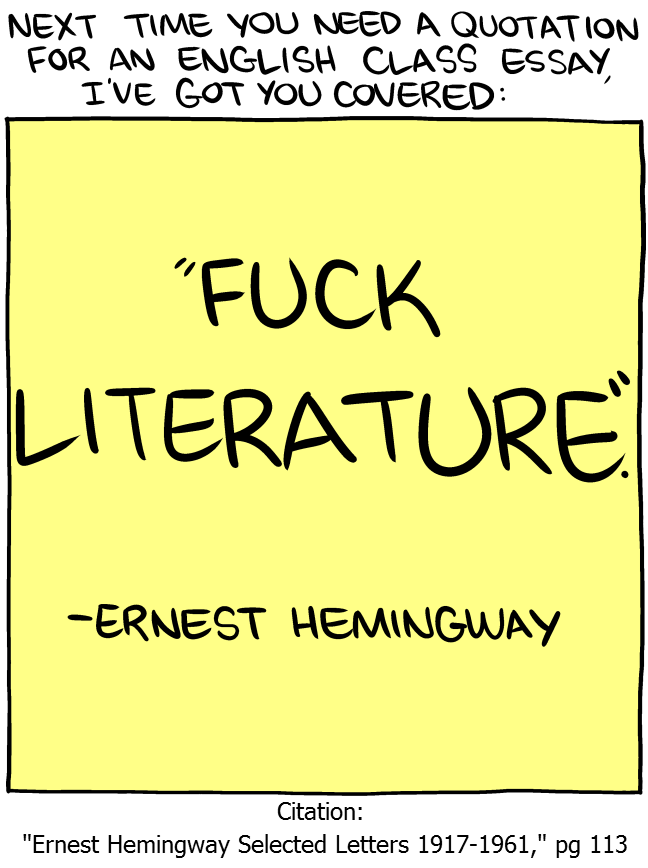
Mccarthy.tw
Shared posts
07/24/13 PHD comic: 'Academically'
Mccarthy.twGiven that I'm in lab at 9:22, I want to cry.
| Piled Higher & Deeper by Jorge Cham |
www.phdcomics.com
|
|
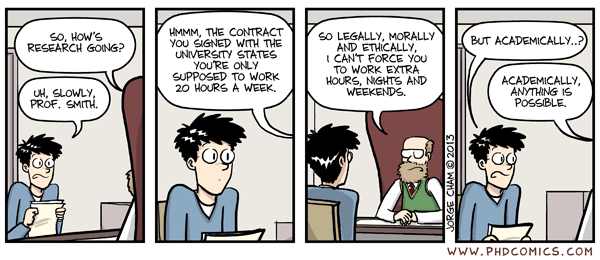 |
||
|
title:
"Academically" - originally published
7/24/2013
For the latest news in PHD Comics, CLICK HERE! |
||
Self-Help
In 1921, Pennsylvania surgeon Evan O’Neill Kane removed his own appendix. He wanted to show that a local anaesthetic would be adequate for some surgeries but wanted to be sure that a patient could tolerate the procedure. So on Feb. 15, propped up by pillows on an operating table, he cut into his own abdomen, using novocaine to dull the pain while a nurse held his head forward so that he could see the work.
“Just say that I am getting along all right,” he told the New York Times the following day. “I now know exactly how the patient feels when being operated upon under local treatment. … I have demonstrated the fact in my own case that a major operation can be performed by the use of a local anaesthesia without causing pain more severe than can be borne by the patient.”
He was 60 years old at the time. Nine years later he would repair his own hernia.
Internet Arguments
SDCC is just days away! I’m going to be there, hawking my wares at the Dumbrella booth, located in the heart of the webcomics pavillion at Table 1337. Won’t you stop by and say hello?
I’m going to have bunnies, stickers, magnets, buttons and lots and lots of books, including a small internationally-expressed bundle of brand-new Goats IV: Inhuman Resources books and the also-brand-new SFAM 2: Business Animals.
I’m freaking out. Are you freaking out? It’s so close now.
Just a reminder: new SFAM Wallpapers are still available! I’ve put up two new wallpapers on our pay-what-you-like wallpapers page. If you can, please chip in a dollar or two or five and download any or all of these wallpapers for use on your desktop computer. Your contributions help keep me and my family in business!
Overtime

Suppose that, at a given moment, a certain number of people are engaged in the manufacture of pins. They make as many pins as the world needs, working (say) eight hours a day. Someone makes an invention by which the same number of men can make twice as many pins: pins are already so cheap that hardly any more will be bought at a lower price. In a sensible world, everybody concerned in the manufacturing of pins would take to working four hours instead of eight, and everything else would go on as before. But in the actual world this would be thought demoralizing. The men still work eight hours, there are too many pins, some employers go bankrupt, and half the men previously concerned in making pins are thrown out of work. There is, in the end, just as much leisure as on the other plan, but half the men are totally idle while half are still overworked. In this way, it is insured that the unavoidable leisure shall cause misery all round instead of being a universal source of happiness. Can anything more insane be imagined?
– Bertrand Russell, “In Praise of Idleness,” 1935
DNA and RNA “Traffic Lights”: Synthetic Wavelength-Shifting Fluorescent Probes Based on Nucleic Acid Base Substitutes for Molecular Imaging
About.com Just About Makes Me Vomit
Whenever you search for any standard do-it-at-home chemistry demo, most of the time you will come across an entry on About.com. About.com is a site that tries to gobble up pageviews so it can attract advertisers, and one method they use for doing this is to pay “guides” to write about popular topics within a particular subject area.
The guide for chemistry is Anne Marie Helmenstine, who earned a Ph.D. in biomedical sciences from the University of Tennessee. Probably sensing an opportunity to gobble up pageviews, Dr. Helmenstine jumped on the liquid nitrogen pool party story. If all she wanted to do was attract hits, that was an excellent plan. Yesterday alone, ChemBark got 21k pageviews, which is about 7-10 times what the site gets on a typical day with a fresh post. But, if your job is to educate and inform, I would not recommend writing this:
Nitrogen is principal gas in air, so it it’s quite safe on its own, but the liquid nitrogen was believed to have reacted with treatments in the pool, releasing toxic gas. How do you avoid hospitalizing your party, if you want liquid nitrogen fog? Simply add the nitrogen to ordinary water, not chemical-treated water. You’ll get fog without additional compounds. The principal risk from liquid nitrogen fog is from asphyxiation. Adding more nitrogen to the air decreases the relative amount of oxygen. This isn’t an issue so much in an outdoor pool, but should be a consideration if you have an enclosed pool. It’s safer to use a fog machine or make real water-based fog in that situation.
That is Dr. Helmenstine’s expert advice, and it is atrocious. First, there is very little chance the nitrogen reacted with the hypochlorite in the pool. Second, adding the liquid nitrogen to non-chlorinated water would have posed the same danger to life as adding it to chlorinated water. Finally, to write that this “isn’t an issue so much in an outdoor pool” is not only wrong, it is a public health hazard. The pool party disaster took place at an outdoor pool.
Ugh!
Unquote
“If I could remember the names of all these particles I’d be a botanist.” — Enrico Fermi
Sue the “Chemical-Free” Bastards
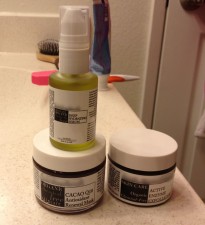 While I’m an idealist at heart, in my old age, I’ve increasingly found myself giving in to apathy and letting things slide more often. In the shower this weekend, I saw another one of my fiancée’s hair-care products advertised as “chemical free” and was soon awash in the same frustration expressed in this old post. The phrase “chemical free” is profoundly stupid, it is damaging to our field, and the problem is getting worse. While a lot of frustration has been expressed by a small group of chemists online, I’ve seen no effective campaign against the stupidity of the term “chemical free.” On the flip side, you’ve got another group of chemists who find the argument against “chemical free” to be pedantic, and some have even embraced the term for use in lab.
While I’m an idealist at heart, in my old age, I’ve increasingly found myself giving in to apathy and letting things slide more often. In the shower this weekend, I saw another one of my fiancée’s hair-care products advertised as “chemical free” and was soon awash in the same frustration expressed in this old post. The phrase “chemical free” is profoundly stupid, it is damaging to our field, and the problem is getting worse. While a lot of frustration has been expressed by a small group of chemists online, I’ve seen no effective campaign against the stupidity of the term “chemical free.” On the flip side, you’ve got another group of chemists who find the argument against “chemical free” to be pedantic, and some have even embraced the term for use in lab.
While I might be closer to abandoning this cause in favor of apathy, I don’t think the problem is worth giving up on just yet. Previously, I have lobbied bench chemists to become more involved in educating the public, suggested that the ACS develop a “war room” to address misinformation in the mainstream media, and volunteered a first draft of a pro-chemicals ad campaign. But maybe that’s my idealism talking. “Positive” approaches, where we tout the benefits of chemistry, require a lot of effort and take time to bring about change. Perhaps it would be more effective to adopt a negative approach? And, of course, what approach could be more negative than to sue?
SUE, SUE, SUE!
Yes, let’s start suing companies that advertise their products as “chemical free”. Make the dummies hurt where it counts: their wallets.
You see, there are laws that require truth-in-advertising, and many of them should be directly applicable to “chemical free” cases. The Federal Trade Commission has explained its policy for how it judges whether or not it will act on potentially deceptive ads:
Certain elements undergird all deception cases. First, there must be a representation, omission or practice that is likely to mislead the consumer. Practices that have been found misleading or deceptive in specific cases include false oral or written representations, misleading price claims, sales of hazardous or systematically defective products or services without adequate disclosures, failure to disclose information regarding pyramid sales, use of bait and switch techniques, failure to perform promised services, and failure to meet warranty obligations.
Second, we examine the practice from the perspective of a consumer acting reasonably in the circumstances. If the representation or practice affects or is directed primarily to a particular group, the Commission examines reasonableness from the perspective of that group.
Third, the representation, omission, or practice must be a “material” one. The basic question is whether the act or practice is likely to affect the consumer’s conduct or decision with regard to a product or service. If so, the practice is material, and consumer injury is likely, because consumers are likely to have chosen differently but for the deception. In many instances, materiality, and hence injury, can be presumed from the nature of the practice. In other instances, evidence of materiality may be necessary.
Thus, the Commission will find deception if there is a representation, omission or practice that is likely to mislead the consumer acting reasonably in the circumstances, to the consumer’s detriment.
So, there are three major criteria for an ad to meet: (i) it must be deceptive, (ii) it must have an impact on a “reasonable” consumer, and (iii) it must induce a material change in behavior on the part of a consumer. Any product which advertises itself as “chemical free” easily meets these three criteria.
First, everything that I have come across as “chemical free” (e.g., cosmetics, fertilizer, sunscreen) has contained chemicals, so the claim is a false written representation of the product. Second, the fear of chemicals is so widespread in society that it is more than reasonable for an average, uneducated consumer to care whether something is “chemical free”. Finally, a “chemical free” label can easily have a material effect in that a chemophobic consumer could choose to purchase a falsely labeled product over a competing product that is not labeled “chemical free” yet contains the same active chemicals.
Unfortunately, it is probably unreasonable for any halfway-decent chemist to claim he was fooled by something as scientifically nonsensical as “chemical free.” But, a class-action lawsuit waged by a group of typical (chemophobic) consumers who’ve purchased a chemical-free product could easily have merit.
Perhaps even more effective would be for a major company (with hefty legal resources) to file lawsuits claiming damages due to unfair business practices. It is unfair to have to compete against rival products that benefit from advertising with false claims. Let’s see these smaller companies have to defend themselves against the giants. Unfortunately, there’s no single chemical-free product on the market that is successful enough to make such a lawsuit a worthwhile cause.
Outside of lawsuits, what can you do? Well, the FTC has an FAQ about what sorts of ads are potentially deceptive, and you can contact them to register a complaint about products making false claims. Some complaints they pursue and some they don’t, but their decisions carry the weight of the law and they can issue cease-and-desist orders as well as fines. You can also register complaints with the Better Business Bureau (BBB) and state/local consumer protection offices.
I’m not saying that lawsuits are the best approach to solving the problem, but in some cases, insisting on the enforcement of existing laws might be an effective solution to the proliferation of all this “chemical free” nonsense.
Awful Idea: Liquid Nitrogen at a Pool Party
There is video circulating tonight of a summer party in Mexico where organizers poured liquid nitrogen into the swimming pool. They weren’t messing around, either—you can see a number of ~10 L dewars being upended into the water.
--Of course, this is a very, very bad idea. Under these conditions, the nitrogen (b.p. = −196 °C) quickly boils and displaces all of the oxygen present, causing people in the area to asphyxiate. Remember, it only takes 28 g of liquid nitrogen to displace 22.4 L of air at standard temperature and pressure. The fact that you are asphyxiating is masked by your ability to exhale carbon dioxide normally, so the burning sensation you experience when holding your breath or drowning is absent. Furthermore, the thick fog produced upon mixing the liquid nitrogen and water conceals any distress.
It looks like multiple people were hurt at the party and needed to be rescued.
News reports, updated 21 June 2013: Daily Mail (corrected most of the wrong chemistry, but a caption referencing a reaction with chlorine remains), Latin Rapper Blog (corrected to get the chemistry right; gives ChemBark a shout out, see comments), International Science Times (gets it right, credits ChemBark), Excelsior (gets the chemistry wrong), Fox News (gets the chemistry wrong), MSN Now (gets the chemistry wrong), Huffington Post UK (gets chemistry mostly right, credits ChemBark, but still needs to correct photo captions), NY Daily News (gets the chemistry wrong), The Sun (gets the chemistry wrong), The Telegraph (gets the chemistry wrong in the headline), Popular Science (gets the chemistry right, includes interview and link to ChemBark), Slate (corrected the story to get the chemistry right).
Deborah Blum covered the misreports by the media of the chemistry at play on the Knight Science Journalism (KSJ) site. The post links to ChemBark.
Updated note to media: Many outlets have reported that liquid nitrogen will react with chemicals in swimming pools to generate a poisonous gas. This is almost certainly incorrect. Molecular nitrogen is relatively inert and should not react with anything present in the pool, like “chlorine” (mostly, NaOCl) or water. The danger of adding liquid nitrogen to the pool stems simply from the nitrogen’s boiling and pushing away all of the oxygen around, leaving none for the swimmers to breathe. The cloud that is present has nothing to do with poison gas. Rather, it is the same thing as fog. The liquid nitrogen is cold and cools the air close to the pool to the point that water vapor in the air condenses into very tiny droplets that stay suspended. The cloud is fog, generated from the same effect responsible for your being able to “see your breath” when you exhale on a cold day. The visible cloud is not nitrogen and it is not smoke; it is droplets of water suspended in an atmosphere of air that is heavily enriched in nitrogen.
Philip
Mccarthy.twTulpas.
In 1972 the Toronto Society for Psychical Research set out to create a ghost. They invented a character named Philip, an English nobleman from the 17th century, and tried to contact him through sittings in which they discussed his life, to see whether they could induce a “collective hallucination.”
When a year of this produced no results, they adopted the trappings of a more formal séance, introducing colored lights, singing songs, and reciting poetry while trying to conjure Philip’s spirit. After three or four of these sessions, surprisingly, “the group felt a vibration within the table top, somewhat like a knock or rap.”
Philip had, apparently, shown up. After some initial confusion, the group established a convention by which he could express himself — one rap meant yes, two meant no. And he was quite willing to talk:
‘Did you have your own regiment?’ Sid asked.
(Rap) ‘Yes.’
‘Were you wounded in the fighting?’
(Rap, rap) ‘No.’
‘I wonder which battles he fought in,’ Lorne asked. ‘Philip, did you fight at Naseby?’
(Rap, rap) ‘No.’
‘Did you fight at Marston Moor?’
(Rap) ‘Yes.’
‘I wonder what weapons they used?’ Al asked. ‘Did you use pikemen?’
(Rap) ‘Yes.’
‘Would they have had guns of any kind then?’ someone asked.
‘They would have had muskets,’ Lorne said.
(Immediate confirmatory rap) ‘Yes.’
That’s from Conjuring Up Philip, a 1976 account by Iris Owen, a member of the group. With time the rappings grew stronger, and the table would occasionally move around the room and even levitate. Owen wrote, “In addition to sliding across the floor (which incidentally was covered with a thick pile carpet), the table would tilt in various ways, lifting one, two, or three legs, and pivot, sometimes almost dancing.”
It’s hard to know what to make of this. On the one hand, most of Philip’s verbal communications were simply those that the group expected to receive. For example, he said that Charles I had loved cats but not horses or dogs; this isn’t historically accurate, but the questioner was a cat lover. Owen called Philip “a composite of [the group's] own invented imaginations … a character born of their own desire to bring him as much to actuality as they could.”
But the physical tricks are harder to understand. The simplest explanation is that some in the group were deliberately creating the “supernatural” effects, a possibility that all strongly denied. Or perhaps the group really had stumbled into some sort of collective, or wishful, hallucination. Whatever the case, the whole episode shows that even supernatural explorations that are known to be groundless can produce convincingly “otherworldly” effects for a receptive audience. To that extent, Philip was a ghost who helped to disprove his own existence.
Bon Appétit
- It is now true that Clarence will have a cheese omelette for breakfast tomorrow. [Premise]
- It is impossible that God should at any time believe what is false, or fail to believe anything that is true. [Premise: divine omniscience]
- Therefore, God has always believed that Clarence will have a cheese omelette for breakfast tomorrow. [From 1, 2]
- If God has always believed a certain thing, it is not in anyone’s power to bring it about that God has not always believed that thing. [Premise: the unalterability of the past]
- Therefore, it is not in Clarence’s power to bring it about that God has not always believed that he would have a cheese omelette for breakfast. [From 3, 4]
- It is not possible for it to be true both that God has always believed that Clarence would have a cheese omelette for breakfast, and that he does not in fact have one. [From 2]
- Therefore, it is not in Clarence’s power to refrain from having a cheese omelette for breakfast tomorrow. [From 5, 6]
So Clarence’s eating the omelette tomorrow is not an act of free choice.
From William Hasker, God, Time, and Knowledge, quoted in W. Jay Wood, God, 2011.
WHEN I THINK ABOUT MY DECISION TO GO TO GRAD SCHOOL

credit: Caty
Timber!
Mccarthy.twbaha transubstantiation, amirite?
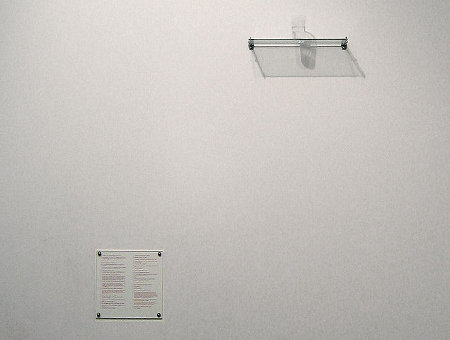
Michael Craig-Martin’s 1973 conceptual artwork An Oak Tree presents a glass of water with a plaque explaining that it’s a tree — not symbolically but literally: “The actual oak tree is physically present but in the form of the glass of water.”
This is a comment on transubstantiation and, by extension, on the patron’s faith in an artist’s presentation of his work, but it backfired: When the National Gallery of Australia bought the piece in 1977, customs officials barred it as “vegetation.”



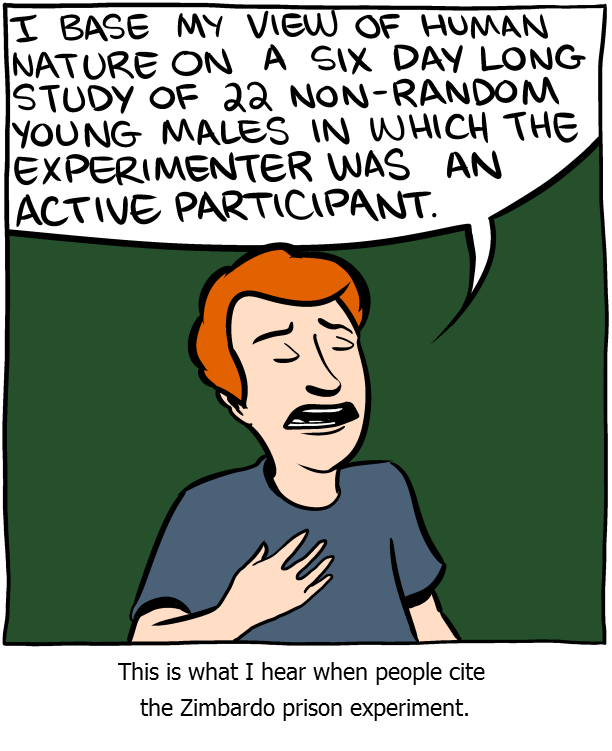




 facebook
facebook  reddit
reddit 



